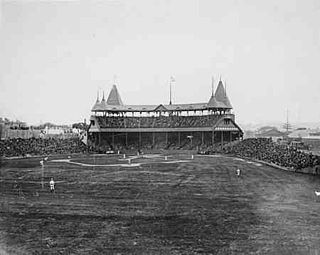
The Polo Grounds was the name of three stadiums in Upper Manhattan, New York City, used mainly for professional baseball and American football from 1880 to 1963. The original Polo Grounds, opened in 1876 and demolished in 1889, was built for the sport of polo. Bound on the south and north by 110th and 112th streets and on the east and west by Fifth and Sixth (Lenox) avenues, just north of Central Park, it was converted to a baseball stadium when leased by the New York Metropolitans in 1880.

National League Park, commonly referred to as the Baker Bowl after 1923, was a baseball stadium home to the Philadelphia Phillies from 1887 until 1938, and the first home field of the Philadelphia Eagles from 1933 to 1935. It opened in 1887 with a capacity of 12,500. It burned down in 1894 and was rebuilt in 1895 as the first ballpark constructed primarily of steel and brick and with a cantilevered upper deck.

South End Grounds refers to any one of three baseball parks on one site in Boston, Massachusetts. They were home to the franchise that eventually became known as the Boston Braves, first in the National Association and later in the National League, from 1871 through part of the 1914 season. That stretch of 43 1/2 seasons is still the longest tenure of the Braves club at any of their various ballparks and cities since 1914.

Ridgewood Park, also known as Wallace's Ridgewood Park or the Wallace Grounds, and frequently confused with Grauer's Ridgewood Park, was a baseball ground in Ridgewood, Queens, New York. Both Wallace's and Grauer's are shown in Belcher Hyde's Map of Newtown in 1915. The baseball field was part of a larger entertainment area bounded Wyckoff Avenue, Covert Street, Halsey Street, and Irving Avenue. The baseball field was southwest of the Long Island Rail Road's Montauk Branch tracks. Eldert Street, although depicted on the map as running through the baseball grounds, was not cut through southwest of the railroad tracks and the road remains interrupted there today. Originally the park was in Queens County, before its incorporation into New York City in 1899. This facilitated Sunday baseball playing, including the charging of admission, beyond the reach of Sabbath enforcers from the then-city of Brooklyn.

West Side Park was the name used for two different ballparks that formerly stood in Chicago, Illinois. They were both home fields of the team now known as the Chicago Cubs of the National League. Both ballparks hosted baseball championships. The latter of the two parks, where the franchise played for nearly a quarter century, was the home of the first two world champion Cubs teams, the team that posted the best winning percentage in Major League Baseball history and won the most games in National League history (1906), the only cross-town World Series in Chicago (1906), and the immortalized Tinker to Evers to Chance double-play combo. Both ballparks were primarily constructed of wood.

Sulphur Dell, formerly known as Sulphur Spring Park and Athletic Park, was a baseball park in Nashville, Tennessee, United States. It was located just north of the Tennessee State Capitol building in the block bounded by modern-day Jackson Street, Fourth Avenue North, Harrison Street, and Fifth Avenue North. The ballpark was home to the city's minor league baseball teams from 1885 to 1963. The facility was demolished in 1969.

The Boston Reds of 1884 were a professional baseball team that competed in the short-lived Union Association.
Recreation Park was the name applied to several former baseball parks in San Francisco, California in the late 19th century and early 20th century.

Edward W. Dowling, better known as Robert Joseph Glenalvin, was an American professional baseball second baseman and manager. He played for the Chicago Colts of the National League in the 1890 and 1893 seasons. His professional career in Minor League Baseball spanned from the 1887 to 1899 seasons, where he served as the player-manager for several minor league teams. Glenalvin was also an umpire in the minor leagues from the 1909 through 1914 seasons.
Tinker Park is the name of a former baseball ground located in Indianapolis, Indiana. The ground was the primary home of the Indianapolis Hoosiers baseball club of the National League from 1887 to 1889, and also of the Indianapolis Blues of the American Association in 1884.
The Southern League was a Class B and Class C minor league baseball league which operated intermittently in the Southern United States from 1885 to 1899. Financial problems plagued the league and its member teams throughout their existence. It was not unusual for teams to depart the league during the season or for the league to cease operations without completing the season. It was this lack of financial support which ultimately caused the league to permanently disband in 1889. In 1901, a new league, called the Southern Association, was created from its remnants.
The Omaha Packers were a minor league baseball team based in Omaha, Nebraska. Between 1879 and 1935, Omaha minor league teams had a long tenure as members of the Western League and Western Association, winning five league championships. Omaha teams played under numerous other nicknames prior to the becoming the "Packers" in 1930.

The Thanksgiving Day Disaster took place in San Francisco on November 29, 1900, at the annual college football game between the California Golden Bears and the Stanford Cardinal, also known as The Big Game. A large crowd of people who did not want to pay the $1 admission fee gathered upon the roof of a glass blowing factory to watch for free. The roof collapsed, spilling many spectators onto a furnace. Twenty-three people were killed, and over 100 more were injured. The disaster remains the deadliest accident at a sporting event in U.S. history.









